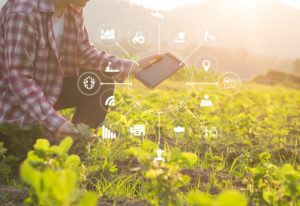Connecting Data Sources for Sustainability
Sustainable agriculture is not the same as sustainability driven by agriculture, nor are the data and technologies needed to get there.
By Marjorie Valin

Sustainability may be agriculture’s biggest buzzword, but there’s an urgency to the hype. Everyone along the supply chain recognizes the pressing need to grow more food, feed more people and slow the rate of climate change.
For farmers to improve soil health, participate in carbon sequestration, produce more food and otherwise benefit from the sustainability movement, there needs to be more data harmonization and interoperability between systems.
“Sustainability of the future is not going to happen with one farmer and one set of data,” says Justin Welch, Syngenta’s commercial lead for digital solutions related to the seed business. “It’s going to be a collaboration, and it’s going to take a very big lift from lots of different sources. It’s going to take everybody from governments to university trials to private industry players to farmers continuing to do what they’ve done, which is collect information and follow good stewardship practices.”
Connecting Data Sources for More Sustainable Farming
While the ag industry has created more data than anyone could ever use, the information is in an abundance of places, languages, and formats. Aggregating, formatting, extracting, and consolidating data from multiple sources into a single structure is a technical challenge that will only increase with adoption of broader sustainability metrics.
Nicholas Elliott, a founder and CEO of the Skyward App Company, says interoperability is a prerequisite for sustainability.
“There’s still a huge gap between the massive data that we’re collecting, the advanced processes that we’re putting behind the sciences and bringing to the table to advance our knowledge,” he says. “When you start to integrate that together, you get emergent properties where you can find even more efficiencies or trends that you couldn’t possibly have seen from each data set individually.”
Climate-Smart Farming
Sustainable agriculture is not the same thing as sustainability driven by agriculture. To achieve the broader goal of a sustainable ecosystem, farmers and suppliers will need to integrate new data points outside traditional precision ag parameters, such as land use data from NASA and the EPA or conservation data from USDA’s National Resources Conservation service.
“The more a farmer can do that connects satellite imagery, the maps the government provides and what the farm is actually doing, the better chance the farmer has of making small changes that can have bigger impact,” says Skyward Apps’ operations director, Katherine Crawford.
Farmers Need Data at their Fingertips
Agriculture and technology are partners in a race that is becoming more urgent. There are two million U.S. farms. Farmers will need to feed another three billion people on the same amount of land by 2050. The only way to grow enough food to feed that many people and slow down the rate of climate change is to help farmers farm sustainably.
Farmers want and need data at their fingertips. Forcing growers to toggle between multiple applications or tools to get the predictive and prescriptive data they need to operate sustainably creates frustration and slows progress.
“Growers are busy; they don’t want to redraw their fields in three different systems in order to get yield maps and see the recommendations for their agronomy or sustainability practices,” says Crawford. “If we force growers to triage their service providers, there’s going to be less data in the system, and it will be harder to make smart analyses.”
All Together Now
When farmers, agribusinesses, manufacturers, governments, and organizations are more connected, they can collaborate to create a better, more environmentally friendly future.
“As you start to see all of those different parties aligned, there’s going to be consortiums and collaborations that allow data to go across all of those different intermediaries to come up with sustainable solutions,” says Syngenta’s Justin Welch. “It’s not going to be just a farmer on his own or the government. It’s got to have the private industry and the government looking at protecting the earth, and farmers wanting to do the same. Then, the private industry will step in and explain how to connect all those things. It’s going to take all of us working together at the same time.”
For more information on making software and data interoperable for growers, visit: skywardapps.com/case-studies/.
For more information on sustainability initiatives, visit www.syngenta.com/en/innovation-agriculture.